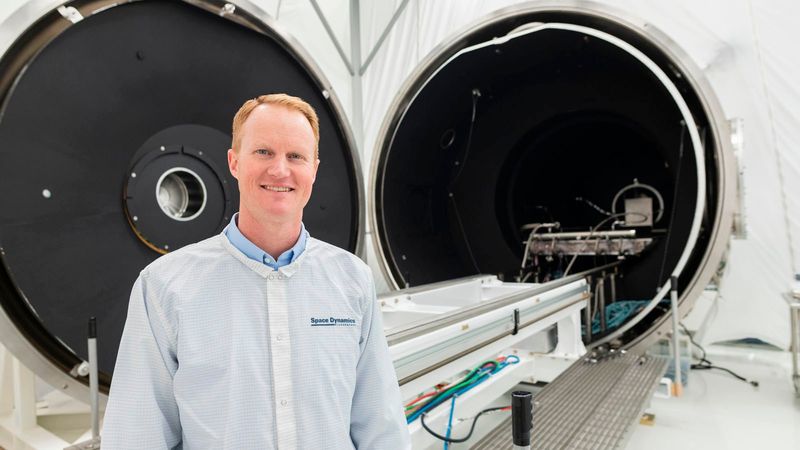
Dr. Jed J Hancock, president of the Space Dynamics Laboratory, has been selected as a Fellow of SPIE, the international society for optics and photonics. Hancock is pictured in this Feb. 15 photo with the Thermal and Optical Research chamber at an SDL facility on USU's Innovation Campus. (Photo Credit: SDL/Allison Bills)
Utah State University’s Space Dynamics Laboratory President Dr. Jed J Hancock has been selected as a Fellow of SPIE, the international society for optics and photonics. He joins distinguished academic and industry leaders from across the globe who have been selected as Fellows of the Society for their technical achievements and service to the optics and photonics community.
Hancock is an expert in optical sciences, systems engineering and program management. He has served as a program manager for numerous civil and military space programs and as an optical science and engineering resource at SDL. He specializes in designing and analyzing electro-optical systems and has led space instrumentation program teams developing infrared, visible, and ultraviolet systems. He managed the camera detector assembly program at SDL for NASA’s Origins, Spectral Interpretation, Resource Identification, Security-Regolith Explorer (OSIRIS-REx) mission.
Hancock took the helm of SDL on July 1, 2021. He earned bachelor’s and master’s degrees in electrical engineering from USU and a master’s degree and doctorate from the University of Arizona’s College of Optical Sciences. His research encompasses electro-optical system design, remote sensing and calibration.
SDL was founded in 1959 and has more than 60 years of experience in remote and in-situ sensing. The laboratory designs, builds and tests science instruments in wavelengths from ultraviolet through infrared, as well as space, airborne and maritime intelligence, surveillance and reconnaissance systems. These systems collect critical imagery and other data products for applications such as astronomy, atmospheric research, missile detection, track custody, space domain awareness and tactical reconnaissance. SDL’s expertise covers many sensor types and applications, including electro-optical, space environments, radar, lidar, pointing control and environmental sampling.
SDL is one of 15 Department of Defense University Affiliated Research Centers, or UARCs. UARCs were established to operate in the public interest rather than in the interest of corporate shareholders and have become crucial partners in developing advanced defense technology while sustaining national engineering and scientific expertise.
As a UARC and a nonprofit organization affiliated with a university, SDL’s core competencies span various technical areas. From researching and developing small satellite systems and subsystems to sensor technologies and cyber capabilities, SDL has played a vital role in defending the United States and protecting our military servicemembers. As a UARC, SDL rapidly develops and deploys mission-driven capabilities to support an array of DoD user needs.
SDL also supports NASA’s mission to explore the unknown in air and space, innovate for the benefit of humanity, and inspire the world through discovery.
SDL is leading NASA’s Atmospheric Waves Experiment to study atmospheric gravity waves in Earth’s atmosphere to gain a deeper knowledge of the connections caused by climate systems throughout our atmosphere and between the atmosphere and space. The AWE mission is planned to be flown on the International Space Station and is part of NASA’s Explorers Program under the Goddard Space Flight Center Explorers and Heliophysics Projects Division. The mission is led by Principal Investigator Dr. Michael J. Taylor at USU. SDL is building the AWE instrument and is also providing project management, systems engineering, safety and mission assurance and mission operations.
SDL is also building six small satellites for NASA’s Sun Radio Interferometer Space Experiment mission, known as SunRISE. Planned to launch as a hosted rideshare with a larger primary satellite, the SunRISE constellation of six CubeSats will fly in a loose formation, acting as a single radio telescope to observe low-frequency emissions from solar activity and share the data with scientists via NASA’s Deep Space Network.
Headquartered on Utah State University’s Innovation Campus in North Logan, Utah, SDL is a nonprofit organization owned by USU. More than 1,000 dedicated SDL engineers, scientists, business professionals and student employees solve technical challenges faced by the military, science community, and industry and support NASA’s vision to explore the secrets of the universe for the benefit of all. SDL has field offices in Albuquerque, New Mexico; Chantilly, Virginia; Dayton, Ohio; Huntsville, Alabama; Ogden, Utah; and Stafford, Virginia. For more information, visit www.sdl.usu.edu.
Contact
- SDL Public Relations
- 435-713-3054
- pr@sdl.usu.edu